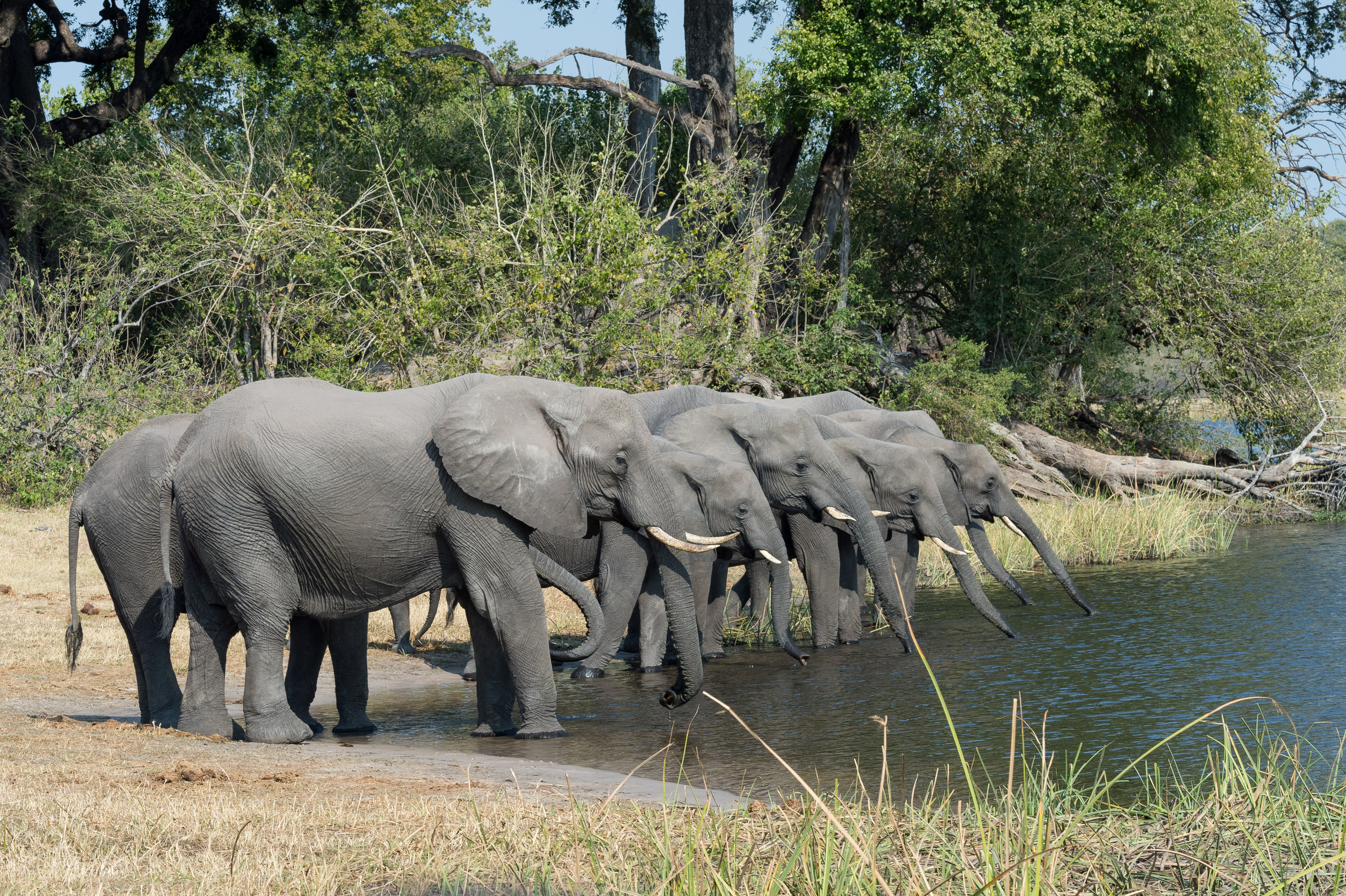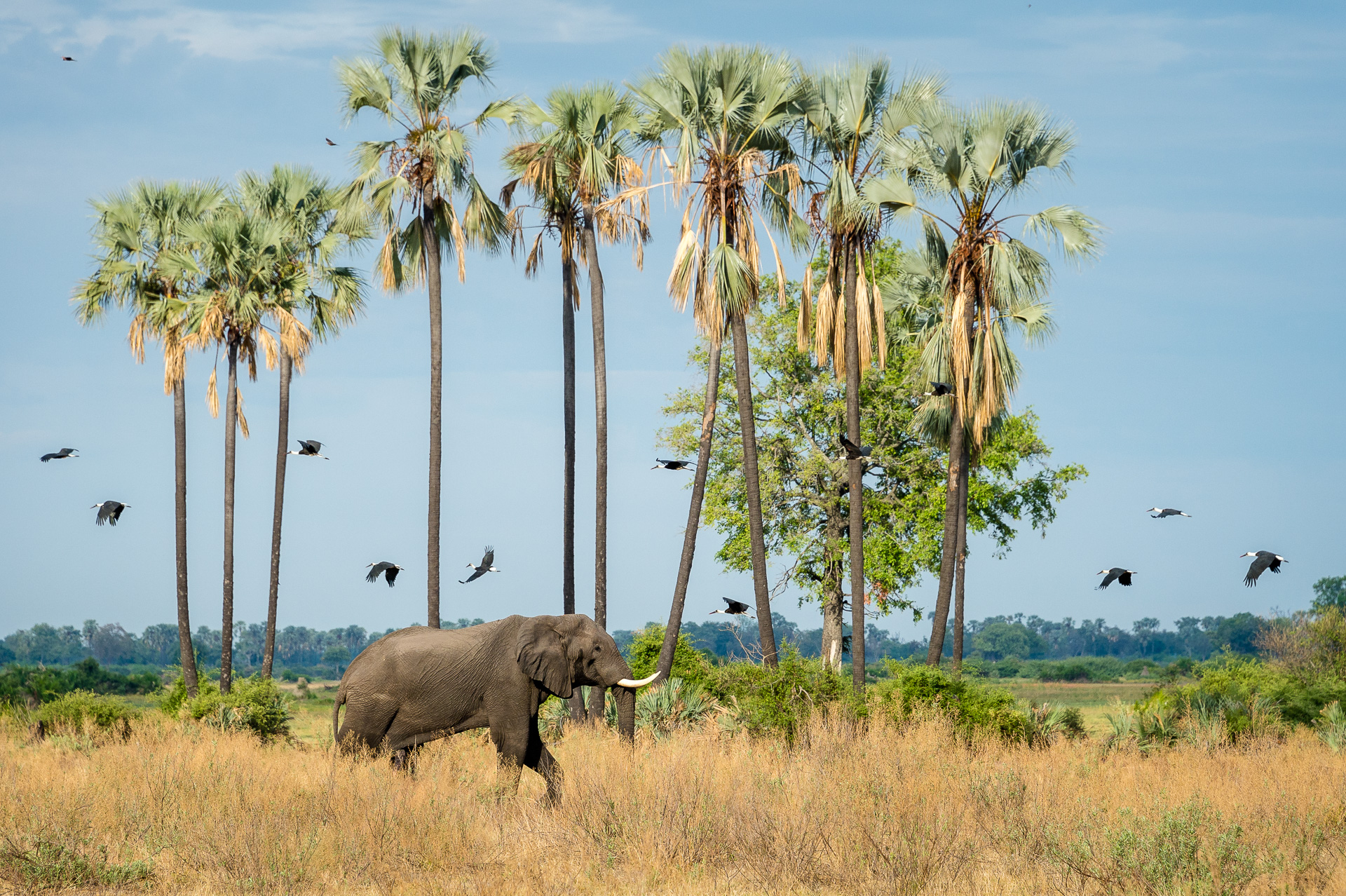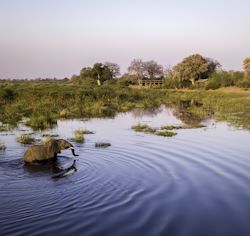The remarkable African bush elephant

Nothing quite compares to the commanding presence of African bush elephants. As the largest land mammals on Earth, they can weigh up to seven metric tonnes (roughly 15,000 pounds), and loom at an impressive height of four metres (about 13 feet).
Their sheer size, along with their extraordinary trunks and ears – is enough to evoke wonder. But it’s the profound impact they have on the environment, their remarkable intelligence and what they represent, that truly commands awe. It’s no wonder that safari-goers are often moved to tears by African elephants.
As we go about our modern lives, we easily forget the immense power – physical and otherwise – of these gentle giants. We forget that there is a wild world out there, a world of titans, who deserve more than just our admiration – they deserve our respect and protection. And so do the ancient corridors they’ve traversed for centuries. This is precisely why we take our custodianship of the Linyanti Wildlife Reserve so seriously. The pristine wilderness area is home to one of the densest elephant populations in Africa, and two vital elephant corridors, both of which border our Wilderness DumaTau camp.

The wisdom of giants
African elephants have been migrating along the same pathways for generations, moving with the seasons in search of the right climate, water and food. But these intelligent beasts don’t migrate at the same time each year, like other species do, following the schedule of the rains. Elephants are so in tune with the land, and so sensitive to environmental cues, that they choose to migrate when they deem it necessary. It’s thanks to their high level of intelligence that they can make these adaptive decisions in order to survive.
Their remarkable memories – which span decades – also play a crucial role in their survival. The matriarch of a herd draws on her knowledge of the past to guide the group to watering holes and foraging locations that are safe from both human and non-human threats. These matriarchs are often the oldest and wisest herd members, and can tap into generations of innate knowledge and learned behaviour to ensure safe migration.

African elephants also utilise a remarkable form of communication to learn about resources and migration routes from other herds – infrasonic vibrations, which are low-frequency sounds imperceptible to humans. These infrasonic communications have been found to be possible at varying distances, with some studies finding they can be generated and detected at distances of 10 kilometres (about six miles) and more.
Architects of the wild
Sometimes referred to as “ecosystem engineers”, the elephants in the Linyanti have a significant impact on the environment, making them what’s known as a keystone species – an ecological term for a species with a disproportionate effect on the ecosystem compared to other animals. Impalas, for example, are drawn to wide open spaces, and it’s in-part thanks to the local elephant herds clearing the way that such plains exist.
Wild dogs also take advantage of the corridors created by elephants, utilising the routes to travel between their fragmented habitats. The increased visibility and manoeuvrability along the corridors aids them in the hunt and provides vital connectivity between hunting grounds and denning sites, reducing the likelihood of human-wildlife conflict.
Unrestricted elephant movement is also critical for the dispersal of many flora species. Elephants feast on plants, fruits and leaves that contain seeds, then pass these seeds through their dung across several kilometres of land. These nutrient-rich seed deposits help spread plant species far beyond their original locations, fostering biodiversity. This can be seen in action throughout the Linyanti region; numerous palm trees across the landscape exist today because of the free movement of elephants.

Even the dung left behind by elephants acts as a vital food source for countless other species, such as the dung beetle. In fact, elephant dung is a critical component in the dung beetle’s lifecycle, providing an ideal environment for laying eggs.
For endangered species like the African wild dog, and overlooked species like the dung beetle, the importance of elephants and their migration corridors cannot be overstated. From species big and small to the very land they inhabit, Botswana needs elephants – and so does the rest of the continent, and the world.
In the Linyanti Wildlife Reserve and across our collective, we make space for elephants – and all wildlife. During the construction of Wilderness DumaTau and Little DumaTau, for instance, great care was taken to preserve the ancient wildlife corridors that local herds still utilise today. DumaTau was designed with their needs in mind – not ours, ensuring that elephants can travel freely through the corridors to the east and west of camp, and pass through the camp itself, should they need to.
“Tourism activities in sensitive environments will always have some level of impact; however, at Wilderness, it is our commitment as conservation-focused hospitality specialists to look for ways where we can be of the environment, and not on the environment. Respecting these ancient elephant corridors is just one such way”, notes Wesley Hartmann, Head of Conservation and Environmental Operations for Wilderness Botswana.
Humans continue to erect fences, pave roads and build walls that impede elephants’ free movement. As they cross borders that only humans recognise – travelling between Botswana, Namibia, Zambia and Angola – human-elephant conflict (HEC) inevitably arises. Apart from the threat of poachers, there’s also the obstacle of farmlands. Elephants feast on crops, create disruptions as they traipse through local villages, and clash with communities trying to protect their livelihoods. Reducing this HEC is vital to protecting local community members, the elephants, and the wilderness areas they share.
Organisations like Ecoexist are doing vital work to reduce this conflict in Botswana’s eastern Okavango panhandle area, working to create an environment where both humans and elephants can coexist in harmony. With a mission so close to our own hearts, Wilderness has been a proud conservation partner with Ecoexist since 2019, providing resources and support to assist the organisation wherever possible.

Research is a vital component of reducing human-elephant conflict. By studying elephants’ movements, with the help of elephant tracking collars donated by Wilderness, Ecoexist is working to identify important micro-corridors that, if restricted, could lead to dangerous conflict. The data captured includes hourly GPS locations which are accessed by the Save the Elephants Wild Tracks app, offering real-time information and movement mapping. This tracking ability also allows for aerial monitoring to take place, which ensures the wellbeing of the collared elephants.
“Wilderness Botswana is proud to be able to support Ecoexist so that they can continue to seek ways to reduce conflict and foster coexistence between elephants and humans. The collaboration has been integral to our impact mission. In regions where competition for water, food, and space is intense, Ecoexist is pioneering and implementing solutions beneficial for both species”, adds Wesley.
Data captured from the collars should also, according to Ecoexist, “provide clear rationale for careful land use planning and policies that recognise elephant pathways as protected habitats, and enable farmers to plant fields in areas that can be better protected from elephants...in order to promote coexistence”.

Fostering human-elephant coexistence
Careful land-use planning around future agricultural development is key, but in the meantime, Ecoexist is attempting to mitigate conflict by equipping farmers with affordable and practical tools and methods to deter crop-raiding. The organisation engages with the local community, educating farmers on producing better yields and harvesting earlier, both to avoid conflict with elephants and to safeguard food security. Wilderness supports these elephant-conscious farming practices, allowing local farmers to access farming equipment and donating drought-resistant seeds to help protect their livelihoods.
Ecoexist also encourages farmers to cultivate millet – a crop less appealing to elephants – and partners with the Okavango Craft Brewery to incentivise this practice. The brewery purchases millet from small-scale farmers at a premium price, and Wilderness supports this initiative by purchasing the brewery’s beer and serving it at its camps in the area. This ultimately creates more demand for the millet and thereby supports local farmers who are helping create a self-sustaining conservation economy.

Encouraging millet farming is just one of many elephant-aware farming practices encouraged by Ecoexist. The organisation also supports the Diyoveya Honey Project, which is a vital initiative in the burgeoning elephant economy. Diyoveya is a Hambukushu word meaning “abundance of elephants”. The bees from the hives safely prevent elephants from raiding farmers’ crops, and act as natural deterrents in the villages themselves. Additionally, the sale of the honey provides local beekeepers with a sustainable way to make a living. A few years ago, Wilderness donated 70 hives to the project, and this year, with the Project’s first harvest, Wilderness bought all available honey at a premium, which is now the key ingredient in a signature cocktail at Wilderness Vumbura Plains and Little Vumbura.

Supporting the creation of conservation economies
As custodians of the Linyanti Wildlife Reserve, Wilderness is committed to protecting both the people in the surrounding communities and the wildlife they live alongside, supporting Ecoexist in building a sustainable conservation economy.
“It is through the development of these economies, which entails the collaboration of conservation organisations, local farmers, businesses, community leaders and tourism operators like Wilderness, that all of this is possible, and we extend our deepest gratitude to all the stakeholders involved”, concludes Wesley.
Ultimately, the collective efforts in the Linyanti, and across Botswana, help create a resilient conservation model where economic development and wildlife preservation work together, securing the future for both local communities and wildlife.


Let’s plan your next journey
Ready?
When we say we’re there every step of the way, we mean it, literally. From planning the perfect circuit, to private inter-camp transfers on Wilderness Air, and easing you through Customs. We’re with you on the ground, at your side, 24-7, from start to finish. Ready to take the road less travelled? Contact our Travel Designers to plan an unforgettable journey.